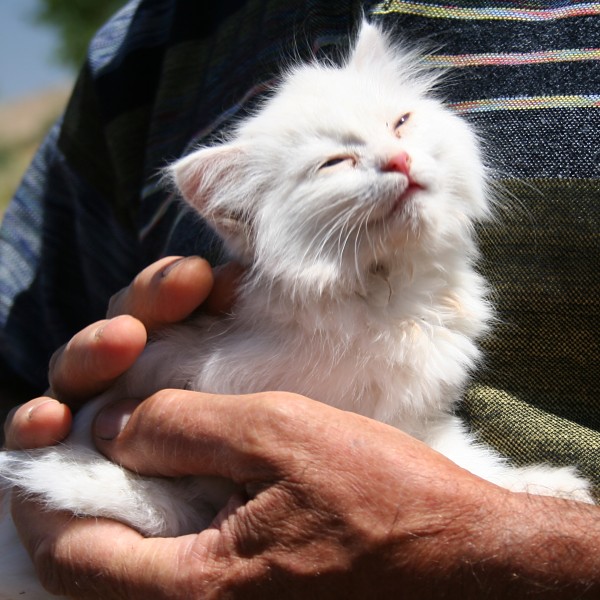- Van Kedisi
Infobox Catbreed
name = Van Kedisi

imagecaption = A Van Cat kitten from the village of Agarti (former Ayanis), near Van city.
altname = Van Cat
nickname =
country =Lake Van ,Turkey
notrecognized =
extinct =
cfastd =
fifestd =
ticastd =
gccfstd =
aacestd =
acfastd =
acfstd =
ccastd =
otherstd =
note = |:"Van cat" redirects here. You may be looking for
Turkish Van ."The Van cat ( _tr. Van Kedisi, _hy. Վանա կատուtransliteration : transl|hy|Van'a Gadou, is a distinctive breed of domesticcat that is found mainly in theLake Van region ofTurkey .It is large, all white, and is often found with mismatched
eyes http://newspot.byegm.gov.tr/2006/february/ns11.htm]History
The Van Cat has been reported living in the vicinity of the city of Van for centuries, and
medieval sources mention white cats as being one of the exports of the Van region.Characteristics
The cats are notable for their lean, long-legged appearance. They are reported to like water more than most cats, and have been seen
swimming inLake Van . They are described as being "terrible house pets". They are reported to be friendly and intelligent, but also to howl more than meow, take pleasure in breaking things, and are very jealous of other animals in the house. Also, given the scarcity of the breed, fewveterinarians willspay or neuter them Fact|date=June 2008.Their most notable genetic characteristic is their often mismatched almond-shaped eyes. The most valued and valuable members of the breed generally have one amber-green eye and one blue eye. They also reportedly have a genetic tendency to deafness.
Current status
During the late 1990s the Van Cat emerged as an informal
municipal symbol of the city of Van – an enormousstatue of a Van Cat andkitten now stands at the entrance to the city, and the cat appears in a localcomic strip , and in the logos of bus companies, shopping centres, various businesses, etc. Ironically, this paralleled a serious decline in Van Cat numbers.In the mid-1990s the "Van Cat House", a Van Cat breeding and research center, was established within the campus of Van University (Van Yüzüncü Yıl Universitesi / "Van Hundredth Year University"). However, reports have revealed that the living conditions for the cats held there leaves much to be desired, and the
breeding program seems to be ineffective in reversing the Van Cats’ declining numbers. The center currently (2006) houses about 100 adult, young cats, and kittens, and is open to the public for a nominal entrance fee (currently 1 lira). [Most of the above information is contained in "Van City Guide", Ankara, 2005.]At the end of the 19th century,
Sultan Abdul Hamid II is said to have owned a Van Cat, and owning a Van Cat is still seen as a status symbol: aPrime Minister of Turkey received one as a gift, and an ambassador from Greece put himself on a waiting list to get one. Kittens for the breeding center could be purchased for $30 in 2006, but their export from Turkey is theoretically outlawed (with a reported fine of $50,000. Fact|date=February 2007 )To increase the population of the Van Kedisi, the local government of Van instituted a program which would pay residents the equivalent of $200.00 per month to keep one. This program was discontinued by a later government.
ee also
*
Turkish Van - A breed descended from two kittens from the Lake Van region.
*Turkish Vankedisi - A breed name accepted by some cat registries to refer to Van Cats and all white Turkish Vans.References
*"Van, Turkish Republic Ministry of Culture information book 62", Ankara 1994.
*"Van City Guide", Ankara, 2005.
*"Van", Gezi pocket guides, Istanbul, 2004.
* [http://www.guide-martine.com/easternanatolia2.asp Travel Guide to Turkey]
* [http://home.tiscali.nl/vanindex.htlm/files/engels.htm Turkish cat; dazzling beauty from the oriental culture.]External links
* [http://www.kultur.gov.tr/EN/BelgeGoster.aspx?17A16AE30572D313E603BF9486D4371DDA30FFB887DE099B Van cat] at the Republic of Turkey Ministry of Culture and Tourism website.
* [http://www.vancat.org VanCat.org] - a website about Van Cats.
Wikimedia Foundation. 2010.
